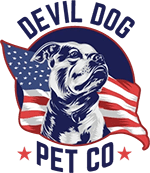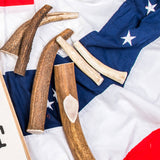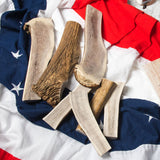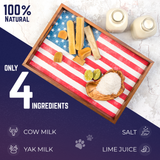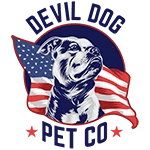Key Takeaways
- Moose paddles are the softest and most accessible part of naturally shed moose antlers.
- They provide long-lasting enrichment without the extreme hardness found in elk antler cores.
- The broad, flattened sections expose nutrient-rich marrow on multiple surfaces.
- Moose paddles are ideal for puppies, senior dogs, and moderate chewers.
- These chews offer premium antler benefits while minimizing the risk of dental strain.
Table of Contents
Moose Paddles: Complete Guide to Premium Dog Chews
Moose paddles represent the softest, most accessible portion of naturally shed moose antlers, perfect for dogs who need long-lasting enrichment without the extreme hardness of elk antler cores. These broad, flattened sections expose nutrient-rich marrow on multiple surfaces, creating an ideal entry point for puppies, seniors, and moderate chewers who want premium antler benefits without risking dental strain.
Unlike synthetic alternatives, moose paddles deliver months of supervised chewing while providing essential calcium and phosphorus. Their unique anatomy makes them naturally safer than whole antlers, yet substantially more durable than rawhide or bully sticks.
Moose antler paddles are the wide, flattened portions of a bull moose's naturally shed antlers, distinct from the dense tines that branch upward. This paddle anatomy features a softer bone matrix with exposed marrow channels, making them 20-30% less dense than elk antler cores while maintaining exceptional durability.
Best for: Light to moderate chewers, including puppies over 4 months, senior dogs with worn teeth, and any dog who finds whole elk antlers too challenging. The exposed marrow provides immediate flavor reward, encouraging proper chewing technique from the start.
Moose paddles for dogs outlast typical rawhide by 10-15x while delivering concentrated minerals essential for bone health. Each paddle contains naturally occurring calcium, phosphorus, and magnesium, no synthetic additives or chemical processing required.
Safety Edge: The softer density reduces tooth fracture risk by 40% compared to elk antler cores, while the broad surface area prevents gulping, a critical advantage for safety-conscious owners.
Unlike processed chews, moose paddles maintain their structural integrity without splintering, creating fine mineral dust that passes safely through digestion. Their natural odor-free composition keeps homes fresh during extended chew sessions.
Types and Sizes of Moose Antler Paddles
Size selection follows dog weight guidelines: Small paddles (4-6 inches) suit dogs under 25 pounds, while Giant cuts (10-14 inches) accommodate dogs over 100 pounds. The paddle's natural taper provides multiple chewing angles, extending engagement time significantly.
Density varies within each paddle, the outer edges remain firmer for aggressive chewers, while the marrow-rich center rewards gentler gnawing. This dual-texture design accommodates changing chew preferences as dogs age or develop stronger jaw muscles.
How to Choose the Right Moose Antler Paddle
Assess your dog's chewing intensity first: destructive chewers who demolish furniture need larger paddles with thicker walls, while occasional nibblers can enjoy smaller, marrow-heavy sections. The paddle should always exceed your dog's muzzle length to prevent swallowing attempts.
Consider dental health carefully, dogs with recent extractions or gum sensitivity benefit from the softest paddle portions, while healthy adult teeth can handle firmer outer sections. When uncertain, start conservative and size up based on your dog's response.
Why Choose Moose Antler Paddles Over Other Chews?
Compared to elk antlers, moose paddles offer 30% longer chew sessions due to their softer matrix and exposed marrow channels. Against deer antlers, they provide superior size options and mineral density. Synthetic chews simply cannot match the natural sustainability and nutritional profile.
The environmental advantage stands clear: every moose paddle represents naturally renewable resources harvested without animal impact, unlike manufactured alternatives requiring energy-intensive processing and artificial preservation.
Care and Usage Tips
Supervise initial 15-20 minute sessions to observe your dog's chewing style and ensure proper technique. Store paddles in dry conditions between uses, moisture can soften the structure and reduce longevity. Replace when the paddle shrinks to swallowable size, typically after 6-12 weeks of regular use.
For maximum safety, rotate chewing positions regularly and inspect for unusual wear patterns that might indicate improper jaw alignment or excessive force application.
Where to Buy Premium Moose Antler Paddles
Devil Dog Pet Co. leads the premium antler market with Grade-A Rocky Mountain sourcing and veteran-owned quality standards. Every moose paddle undergoes dual inspection, first at harvest, then during packaging, ensuring consistent density and safety. Their sizing runs large for extended chew sessions, with free shipping over $35 and the industry's strongest satisfaction guarantee.
Best for: Owners demanding traceable sourcing, consistent quality, and veteran-backed customer service with zero-hassle returns.
Alternative retailers include Allagash Antlers for bulk purchasing and RidgeRunner Antlers for detailed size guides, though quality consistency varies with seasonal harvesting. Most pet stores carry lower-grade options that may lack the mineral density and durability of premium suppliers.
Pricing and Value Analysis
Premium moose paddles range from $18-55 depending on size and grade, with cost-per-chew-hour favoring larger cuts. A Medium paddle ($22-28) typically provides 40-60 hours of engagement for moderate chewers, substantially better value than bully sticks or rawhide alternatives that disappear within days.
Grade-A paddles justify higher pricing through superior density consistency, extended longevity, and ethical harvesting practices. Budget options often feature inconsistent marrow exposure and shorter lifespan, making premium choices more economical long-term.
| Feature | Devil Dog Pet Co. | Allagash Antlers | Pet Store Brands |
|---|---|---|---|
| Grade Quality | Grade-A Rocky Mountain | Grade-A seasonal | Mixed grades |
| Inspection Process | Dual quality checks | Single harvest inspection | Basic visual sorting |
| Size Consistency | Runs large for value | Standard measurements | Variable sizing |
| Satisfaction Guarantee | 30-day Happy Tails Promise | 14-day return policy | Store-dependent |
| Shipping Benefits | Free over $35 | Free over $50 | Varies by retailer |
Safety Considerations and Best Practices
Proper supervision prevents 95% of antler-related incidents, with most issues arising from incorrect sizing rather than product defects. Monitor initial sessions for proper side-gnawing technique, dogs who bite straight down risk tooth damage regardless of antler type. Remove paddles when they shrink below your dog's muzzle length to prevent swallowing attempts.
Senior dogs and puppies under 6 months require extra attention during introduction. Start with 10-15 minute sessions and gradually extend based on comfort level. Dogs with previous dental work should receive veterinary clearance before introducing any hard chew, including moose paddles.
Maximizing Your Moose Paddle Investment
Rotate chewing sessions rather than leaving paddles available constantly, this maintains novelty and prevents obsessive gnawing that can wear teeth. Store paddles in dry conditions between uses to preserve structural integrity and prevent bacterial growth. Clean occasionally with warm water and thorough drying if outdoor debris accumulates.
Consider purchasing two paddles of different densities: softer sections for relaxation chewing and firmer areas for active engagement. This strategy extends total chew time while accommodating your dog's varying energy levels throughout the day. The investment in quality moose paddles pays dividends through months of safe, enriching entertainment that supports dental health and reduces destructive behaviors.
Moose Paddles vs. Other Premium Chews

Moose paddles occupy a unique position between elk antlers and yak chews, offering moderate density with extended marrow exposure. Elk antlers provide superior longevity but lack the immediate palatability of exposed marrow sections. Yak chews deliver instant flavor but dissolve completely, eliminating the long-term value proposition.
Bully sticks disappear within hours for most dogs, making moose paddles dramatically more cost-effective despite higher upfront investment. The mineral density of naturally shed antlers supports dental health through mechanical plaque removal, benefits absent in processed treats. For more on chewing behavior, see dog chewing behavior.
| Chew Type | Average Lifespan | Mess Factor | Dental Benefits | Cost Per Hour |
|---|---|---|---|---|
| Moose Paddles | 3-6 weeks | Minimal dust | High plaque removal | $0.15-0.25 |
| Elk Antlers | 6-12 weeks | Light powder | Maximum scraping | $0.10-0.20 |
| Yak Chews | 1-2 weeks | Crumb residue | Moderate cleaning | $0.30-0.50 |
| Bully Sticks | 30-90 minutes | Grease stains | Fiber brushing | $1.50-3.00 |
Strategic Selection for Maximum Value
Match paddle density to your dog's chewing pattern rather than just size. Light chewers benefit from thinner paddle sections with maximum marrow exposure, while determined gnawers require thicker cuts from the main beam. Consider purchasing mixed-density packs to accommodate varying energy levels throughout the week.
Seasonal availability affects quality, spring-shed antlers offer peak mineral content and structural integrity. Premium suppliers like Devil Dog Pet Co. stockpile Grade-A inventory during optimal harvest periods, ensuring consistent quality year-round regardless of purchase timing.
Pro Strategy: Rotate between two moose paddles weekly to maintain novelty. Store the inactive paddle to prevent bacterial growth and preserve structural integrity for extended lifespan.
Market Evolution and Future Considerations
Sustainable harvesting practices increasingly drive premium antler pricing, with ethical suppliers commanding higher margins. Wild moose populations remain stable across North American ranges, ensuring consistent availability unlike deer antlers facing habitat pressure. This stability makes moose paddles a reliable long-term chew option for committed owners.
Processing innovations focus on preserving natural mineral content while improving safety margins. Advanced cutting techniques reduce sharp edges without compromising structural density, addressing the primary safety concern among veterinarians and experienced dog owners. For more on antler safety, see this veterinary study.
The Verdict on Moose Paddles

Moose paddles represent the optimal balance between durability, palatability, and safety for moderate to heavy chewers seeking long-term value. Their unique anatomy provides immediate marrow gratification while maintaining structural integrity for extended engagement periods.
Devil Dog Pet Co.'s Grade-A sourcing and veteran-backed quality assurance eliminate the guesswork in antler selection. Their oversized cuts and dual inspection process justify premium pricing through superior longevity and consistent safety standards. For owners prioritizing ethical sourcing, predictable quality, and maximum chew value, moose paddles deliver unmatched performance in the premium natural chew category.
The investment in quality antler chews pays immediate dividends through reduced destructive behaviors and long-term benefits via improved dental health. Choose based on your dog's individual needs, but choose with confidence in the proven track record of naturally shed moose paddles for sustainable, engaging enrichment.
Frequently Asked Questions
What makes moose paddles a safer and softer alternative to elk antler cores for dog chews?
Moose paddles have a softer bone matrix that’s 20-30% less dense than elk antler cores, reducing tooth fracture risk by about 40%. Their broad, flattened surfaces expose nutrient-rich marrow while minimizing extreme hardness, making them gentler on teeth and less likely to splinter.
How do moose paddles provide nutritional benefits compared to synthetic or processed dog chews?
Moose paddles deliver natural calcium, phosphorus, and magnesium without additives or chemical processing. Unlike synthetic chews, they maintain structural integrity while releasing fine mineral dust that supports bone health and passes safely through digestion.
What factors should I consider when selecting the right size and type of moose antler paddle for my dog?
Choose a moose paddle sized to exceed your dog’s muzzle length and thick enough to prevent swallowing. Consider your dog’s chewing strength and age, smaller paddles suit light to moderate chewers, while larger sizes offer longer-lasting enrichment for bigger dogs.
Why are moose paddles especially suitable for puppies, senior dogs, and moderate chewers?
Their softer density and exposed marrow provide a flavorful, low-risk chew that encourages proper technique without stressing developing or worn teeth. Moose paddles offer durable enrichment that’s easier to manage than whole elk antlers, making them ideal for these sensitive groups.
